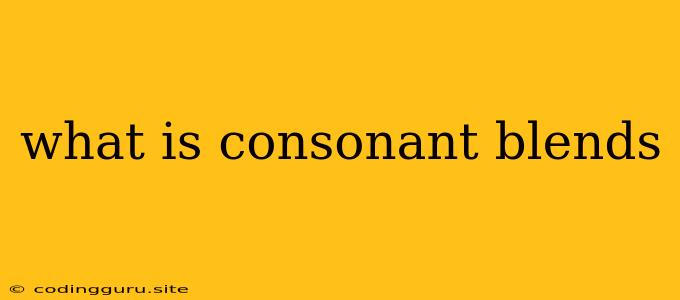What are Consonant Blends?
Have you ever noticed how some words seem to start with two letters that sound like they're being pronounced together? For example, "black," "star," or "flower"? These are examples of consonant blends!
Consonant blends are two or three consonants that are sounded together at the beginning of a word. The sounds blend together, but each consonant sound is still heard.
Let's dive a little deeper into what makes consonant blends so interesting and important:
How do consonant blends work?
Consonant blends work by combining the sounds of two or three consonants to create a single, distinct sound. Imagine these sounds like building blocks. You can combine "b" and "l" to make the "bl" sound in "black". Or you can put "s" and "t" together to make the "st" sound in "star."
Why are consonant blends important?
Consonant blends play a crucial role in building strong reading and writing skills. Here's why:
- Decoding words: When children learn consonant blends, they can start to decode words more quickly and easily. For example, knowing the "tr" blend makes it easier to read words like "train" and "tree".
- Spelling words: Consonant blends are also essential for spelling words correctly. Knowing the "fl" blend helps a child remember the correct spelling of words like "flower" and "fly".
- Enhancing fluency: Recognizing and blending consonant sounds makes reading more fluid and enjoyable. Imagine how much faster you can read if you don't have to sound out each individual letter!
What are some common consonant blends?
There are many different consonant blends in the English language, but here are some of the most common:
- Two-letter blends:
- bl - black, blue, blanket
- br - brown, bread, broom
- ch - chair, chicken, cheese
- cl - cloud, clock, clean
- cr - crayon, crawl, cry
- dr - dress, dream, drive
- fl - flower, fly, flap
- fr - frog, friend, fruit
- gl - glass, glove, glue
- gr - grass, green, grape
- pl - play, plane, plastic
- pr - prince, pretty, prize
- sc - school, scarf, scream
- sk - skate, sky, skip
- sl - sleep, slide, slow
- sm - smile, smoke, small
- sn - snake, snow, snail
- sp - spider, spoon, spot
- st - star, stop, street
- sw - swim, swing, sweet
- th - thumb, thin, thank
- tr - tree, train, truck
- tw - twin, twelve, twist
- wh - whale, what, when
- wr - write, wrong, wrist
- Three-letter blends:
- scr - scream, scratch, screen
- shr - shrink, shirt, shriek
- spl - splash, split, splatter
- spr - spring, spray, spread
- str - strong, straw, street
How to teach consonant blends
Here are some fun and engaging ways to help children learn consonant blends:
- Use picture cards: Create picture cards with words that begin with consonant blends. For example, a picture of a bluebird for the "bl" blend.
- Play games: Turn learning into a game with activities like "Consonant Blend Bingo" or "Consonant Blend Memory Match".
- Read books: Choose books that have words with consonant blends. Point out the blends as you read and encourage children to identify them.
- Sing songs: There are many catchy songs that teach consonant blends. You can find these online or create your own!
Conclusion
Consonant blends are a fundamental part of the English language. By learning to identify and blend these sounds, children build strong reading and spelling skills. Through engaging activities and practice, children can master consonant blends and become confident readers and writers!
